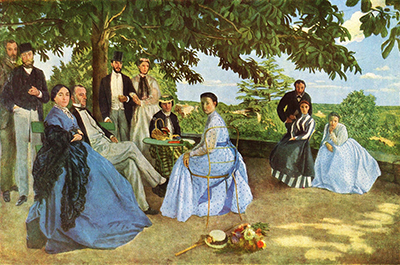The Family Reunion is an oil on canvas painting created in the summer of 1867 and is, arguably, the artist's most famous work. Where possible Bazille preferred to paint outdoors, to utilise natural light and shade. This was the case with The Family Reunion which was painted, almost entirely, in the large garden of the family estate near Montpellier.
As the title suggests, the painting depicts members of the Bazille family. His father and mother sit on a bench surrounded by various relatives including his aunt, uncle and a number of cousins. Bazille also added a portrait of himself, almost hidden, on the left of the picture. Everyone is either sitting or standing in the shade of a large tree. Despite the natural surroundings, there appears to be nothing natural about the poses of the models. They stand, or sit, quite stiffly, and are looking directly towards the artist, not interacting with each other. This posing, along with the life-like quality of the portraits, gives the painting a photographic feel.
The Family Reunion is a perfect example of Bazille's love of light and shade in his paintings. By placing his models under the tree, he can accentuate the vivid blue sky and green countryside in the background. The French artist Frederic Bazille (December 6, 1841 – November 28, 1870) was one of the earliest impressionist painters. His promising career was cut short when he was killed during the Franco-Prussian war.
In 1868 Bazille slightly changed the original painting. On the ground, in front of the family, he added some flowers, an umbrella and a hat. He was also dissatisfied with the way he had painted two of the heads and repainted them. Later that year the painting was accepted by the Paris Salon (the French Academy of Fine Arts official exhibition) at the time the most prestigious and influential exhibition, of its kind, in the world. The Family Reunion is now exhibited in the Mesee d’Orsay museum in Paris, where it is hung with a number of Bazille's other works.




